By Leen Randell
Updated: Jul 03, 2024
10 Best Herbal Teas For Dandruff
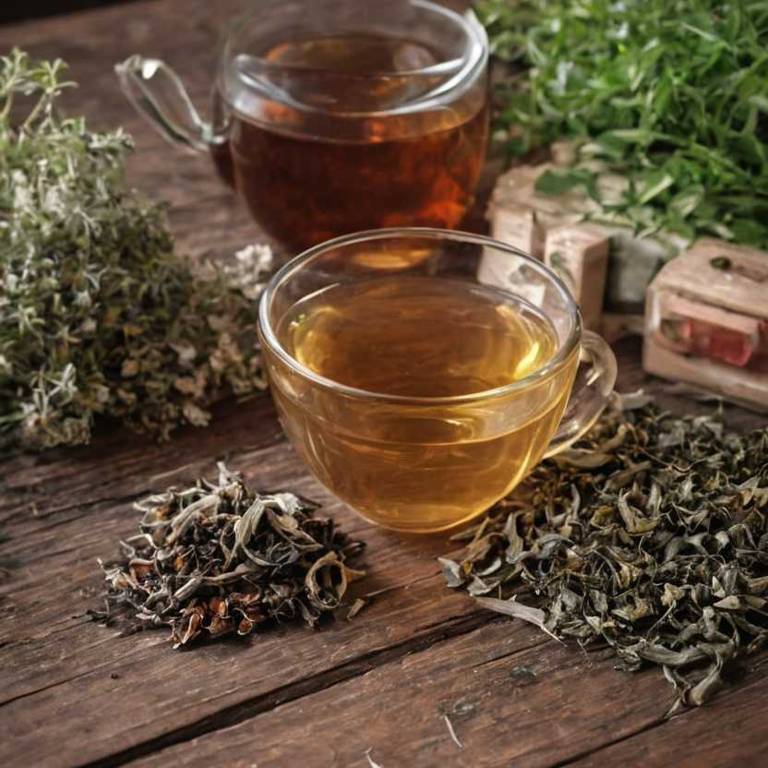
Herbal teas for dandruff are natural remedies made from plants that help soothe and calm the scalp, reducing flaking and itching associated with dandruff.
Teas like peppermint, chamomile, and rosemary have antifungal and anti-inflammatory properties that combat dandruff-causing yeast. Drinking these teas can lead to improved scalp health, reduced dandruff symptoms, and increased confidence.
For instance, a person with dandruff may be able to enjoy outdoor activities without embarrassment, or feel more comfortable in social situations.
The following article describes in detail the most important teas for dandruff, including medicinal properties, parts of herbs to use, and recipes for preparations.
- 1. Sanguisorba minor
- 2. Urtica dioica
- 3. Taraxacum officinale
- 4. Aloe vera
- 5. Calendula officinalis
- 6. Cymbopogon citratus
- 7. Echinacea angustifolia
- 8. Euphrasia officinalis
- 9. Glycyrrhiza glabra
- 10. Hypericum perforatum
- What is the best combination of herbal teas to use for dandruff?
- What ailments similar to dandruff are treated with herbal teas?
1. Sanguisorba minor
Sanguisorba minor, also known as salad burnet, teas helps with dandruff because of its antifungal and anti-inflammatory properties.
The herb contains compounds such as flavonoids and phenolic acids, which help to soothe and calm the scalp, reducing irritation and flaking. It also helps to regulate the pH balance of the scalp, creating an environment that is less conducive to the growth of yeast and fungi that can cause dandruff.
Regular consumption of Sanguisorba minor tea may promote healthy scalp balance and reduce dandruff symptoms.
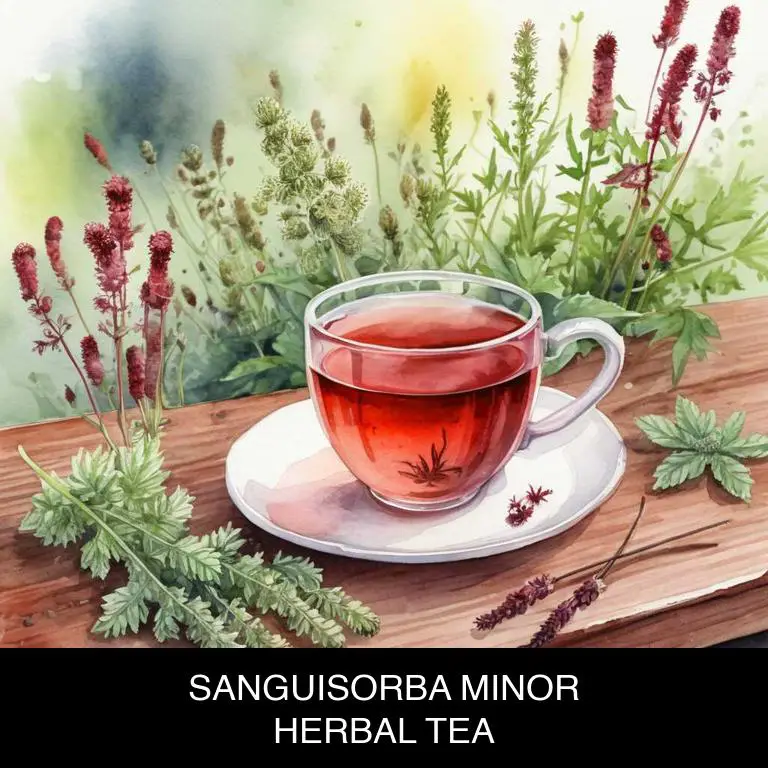
Medicinal Constituents
The list below shows the primary medicinal constituents in Sanguisorba minor teas that help with dandruff.
- Tannins: Tannins in Sanguisorba minor tea have astringent properties that help to reduce inflammation and soothe an itchy scalp, which can contribute to dandruff.
- Phenolic acids: Phenolic acids in Sanguisorba minor tea have antioxidant and anti-inflammatory properties, which can help to reduce oxidative stress and inflammation in the scalp, thereby reducing dandruff.
- Quercetin: Quercetin, a flavonoid found in Sanguisorba minor tea, has anti-inflammatory properties that can help to reduce inflammation and itching in the scalp, which are common symptoms of dandruff.
Parts Used
The list below shows the primary parts of salad burnet used to make teas for dandruff.
- Leaves: Used due to their astringent and antifungal properties, which help to soothe and calm the scalp.
- Roots: Used for their potential to help reduce inflammation and promote healthy hair growth.
- Flowers: Used for their antifungal and antibacterial properties, which can aid in controlling scalp infections that contribute to dandruff.
Quick Recipe
The following recipe gives a procedure to make a basic salad burnet for dandruff.
- Harvest the sanguisorba minor leaves and flowers in the morning after the dew has evaporated to ensure freshness.
- Clean the harvested sanguisorba minor leaves and flowers thoroughly to remove dirt and debris.
- Combine 2-3 teaspoons of the cleaned sanguisorba minor leaves and flowers in a muslin tea bag or infuser.
- Steep the sanguisorba minor tea bag or infuser in a cup of boiling water for 5-7 minutes.
- Strain the tea and discard the solids then serve the sanguisorba minor tea hot or cold as desired.
2. Urtica dioica
Urtica dioica, also known as stinging nettle, teas helps with dandruff because of its anti-inflammatory and antifungal properties.
The tea's active compounds, such as flavonoids and phenolic acids, help to soothe and calm irritated scalps, reducing flaking and inflammation associated with dandruff. Additionally, the tea's antifungal properties help to control the growth of yeast and fungi on the scalp, which can contribute to dandruff.
This natural remedy can provide relief and promote a healthy scalp.
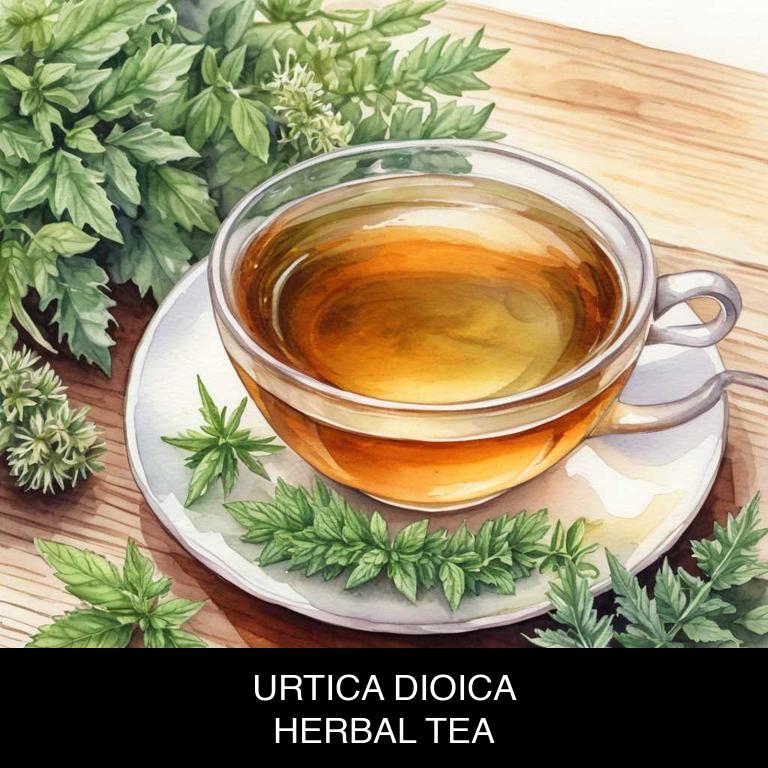
Medicinal Constituents
The list below shows the primary medicinal constituents in Urtica dioica teas that help with dandruff.
- Alkylamides: These compounds help reduce inflammation in the scalp, which is a primary cause of dandruff, and also exhibit antifungal properties to prevent the growth of yeast that can contribute to the condition.
- Flavonoids: These plant-based compounds have anti-inflammatory and antioxidant properties, which can help soothe and calm the scalp, reducing irritation and inflammation associated with dandruff.
- Saponins: These natural compounds have antifungal and antibacterial properties, which can help prevent the growth of microorganisms on the scalp that can contribute to dandruff, as well as reduce inflammation and irritation.
Parts Used
The list below shows the primary parts of stinging nettle used to make teas for dandruff.
- Leaves: They are rich in antioxidants and have anti-inflammatory properties that can help soothe and calm the scalp, reducing dandruff symptoms.
- Stems: The stems of Urtica dioica are also rich in antioxidants and have anti-inflammatory properties, which can help reduce inflammation and soothe the scalp.
- Roots: The roots are rich in vitamins and minerals, including vitamin C and iron, which can help to nourish and balance the scalp, reducing dandruff symptoms.
Quick Recipe
The following recipe gives a procedure to make a basic stinging nettle for dandruff.
- Harvest the fresh leaves and stems of urtica dioica in the early morning after dew has fallen.
- Rinse the harvested plant material under cold running water to remove dirt and debris.
- Chop the plant material into small pieces using sharp scissors or a pair of kitchen shears.
- Steep one teaspoon of the chopped plant material in one cup of boiling water for five to ten minutes.
- Strain the tea through a fine mesh sieve or cheesecloth into a cup to remove solids.
3. Taraxacum officinale
Taraxacum officinale, also known as dandelion, teas helps with dandruff because of its anti-inflammatory and antioxidant properties.
The tea is rich in vitamins A, C, and K, as well as minerals like potassium and iron, which promote healthy scalp conditions. The dandelion's inulin content also helps to soothe and calm the scalp, reducing inflammation and flaking associated with dandruff.
Additionally, the tea's antifungal properties help to combat fungal infections that can contribute to dandruff, making it a potential natural remedy for this common scalp condition.
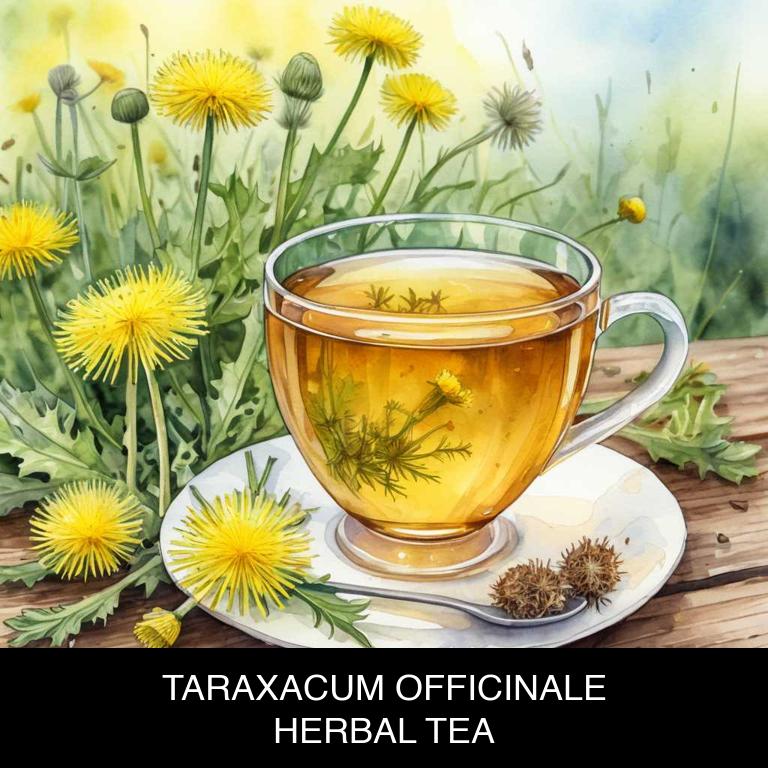
Medicinal Constituents
The list below shows the primary medicinal constituents in Taraxacum officinale teas that help with dandruff.
- Flavonoids: Flavonoids in Taraxacum officinale help with dandruff by reducing inflammation and oxidative stress in the scalp, which can contribute to the development of flaking skin.
- Saponins: Saponins in the herbal tea exhibit antifungal properties, which can help control fungal infections on the scalp that may contribute to dandruff.
- Phenolic acids: Phenolic acids in Taraxacum officinale possess antioxidant and anti-inflammatory properties, which can help soothe and calm the scalp, reducing the severity of dandruff symptoms.
Parts Used
The list below shows the primary parts of dandelion used to make teas for dandruff.
- Leaves: They are used due to their antifungal and anti-inflammatory properties, which can help soothe and calm the scalp.
- Roots: They are used because they contain compounds that have antifungal and antibacterial properties, helping to combat the underlying causes of dandruff.
- Flowers: They are used for their soothing and anti-inflammatory effects, which can help to calm the scalp and reduce flaking.
Quick Recipe
The following recipe gives a procedure to make a basic dandelion for dandruff.
- Harvest 25-30 fresh taraxacum officinale leaves and flowers in the early morning for optimal flavor and potency.
- Rinse the harvested leaves and flowers under cold running water to remove any dirt and debris thoroughly.
- Chop the leaves and flowers into small pieces to increase their surface area for better infusion.
- Steep 1-2 teaspoons of the chopped taraxacum officinale in 8 ounces of boiling water for 5-7 minutes.
- Strain the tea and serve immediately or store it in the refrigerator for up to 24 hours.
4. Aloe vera
Aloe vera, also known as aloe, teas helps with dandruff because of its antifungal and antibacterial properties.
The tea, made from the gel of the aloe plant, reduces inflammation and soothes the scalp, calming irritated skin and promoting healthy hair growth.
Aloe vera's ability to balance pH levels on the scalp also helps to control the growth of yeast and bacteria that can contribute to dandruff, making it a popular natural remedy for this common scalp condition.
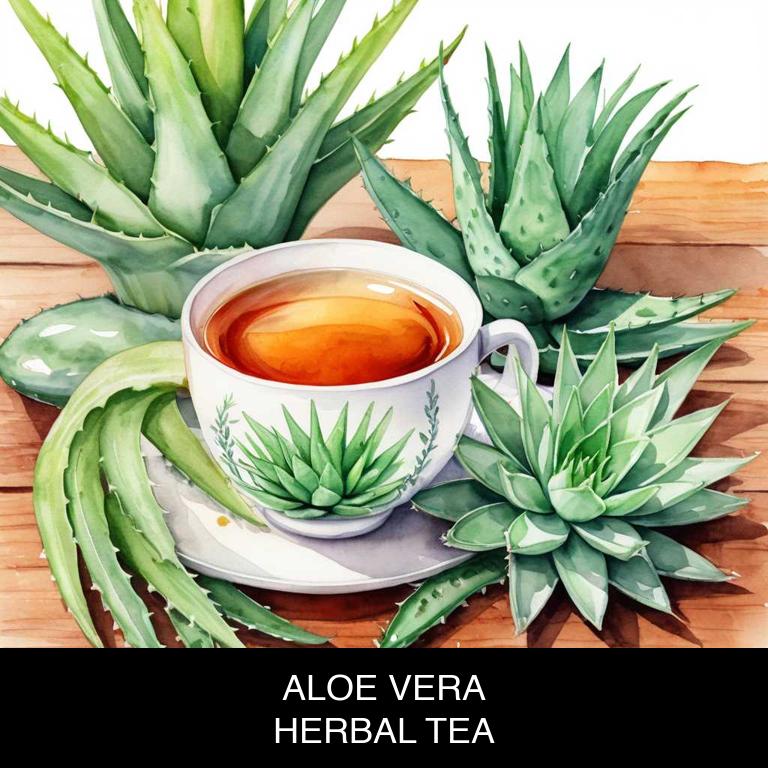
Medicinal Constituents
The list below shows the primary medicinal constituents in Aloe vera teas that help with dandruff.
- Aloe-emodin: Aloe-emodin is a anthraquinone compound with anti-inflammatory and antifungal properties that help soothe itchy scalp and reduce fungal infections that contribute to dandruff.
- Salicylic acid: Salicylic acid is a phenolic compound that exfoliates and unclogs pores on the scalp, reducing flaking and inflammation associated with dandruff.
- Lupeol: Lupeol is a triterpene with anti-inflammatory and antifungal properties that help reduce redness and irritation on the scalp, while also inhibiting the growth of fungal pathogens that cause dandruff.
Parts Used
The list below shows the primary parts of aloe used to make teas for dandruff.
- Leaves: They are the primary source of Aloe vera's medicinal properties, which are used to soothe and calm the scalp, reducing dandruff symptoms.
- Flowers: They contain flavonoids and other compounds that have anti-inflammatory properties, which help to reduce redness and itching associated with dandruff.
- Gel from leaves: The gel extracted from Aloe vera leaves is rich in vitamins, minerals, and amino acids that promote healthy scalp and hair, reducing dandruff and flaking.
Quick Recipe
The following recipe gives a procedure to make a basic aloe for dandruff.
- Harvest 10 to 20 fresh aloe vera leaves of 3 to 4 inches in length and cut them into small pieces.
- Soak the aloe pieces in water for 30 minutes to an hour to reduce their bitterness.
- Strain the aloe mixture through a cheesecloth or a fine mesh sieve to remove pulp and fibers.
- Add 1 teaspoon of the strained aloe mixture to 1 cup of boiling water for 5 to 7 minutes.
- Remove the tea from heat and let it steep for 10 to 15 minutes before serving.
5. Calendula officinalis
Calendula officinalis, also known as pot marigold, teas helps with dandruff because of its antifungal and anti-inflammatory properties.
The tea's active compounds, including triterpenoids and flavonoids, help soothe and calm the scalp, reducing inflammation and irritation that can lead to dandruff. Calendula's antifungal properties also help combat Malassezia, a fungus that contributes to dandruff. Additionally, calendula's moisturizing properties help keep the scalp hydrated, reducing flaking and itchiness associated with dandruff.
Regular consumption of calendula tea may promote a healthy scalp and reduce dandruff symptoms.
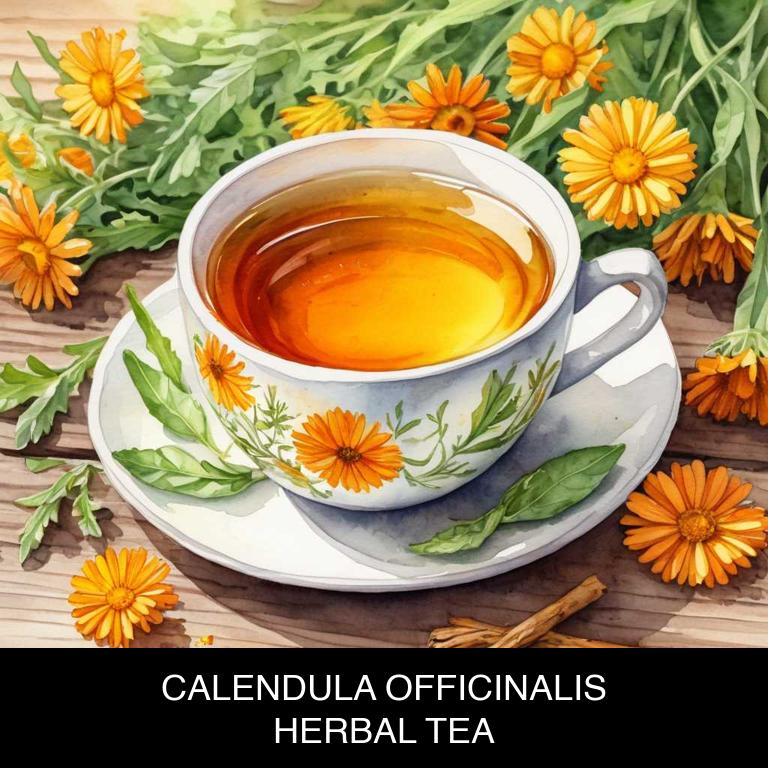
Medicinal Constituents
The list below shows the primary medicinal constituents in Calendula officinalis teas that help with dandruff.
- Carotenoids: These antioxidants help reduce inflammation and soothe the scalp, which can help alleviate symptoms of dandruff.
- Flavonoids: As anti-inflammatory agents, flavonoids in Calendula officinalis may help reduce redness and irritation associated with dandruff.
- Triterpenoids: Saponins, a type of triterpenoid, have antifungal and antibacterial properties that can help control the growth of fungi and bacteria on the scalp, contributing to dandruff.
Parts Used
The list below shows the primary parts of pot marigold used to make teas for dandruff.
- Flowers: They are commonly used due to their high content of flavonoids, which have anti-inflammatory and antifungal properties beneficial for soothing dandruff.
- Leaves: Leaves are often used because they contain salicylic acid, a compound known for its ability to reduce inflammation and promote healthy skin.
- Roots: Roots are sometimes used due to their content of saponins, which have antifungal and antibacterial properties that can help combat scalp infections and irritation associated with dandruff.
Quick Recipe
The following recipe gives a procedure to make a basic pot marigold for dandruff.
- Harvest 20-30 calendula flowers in the morning when they are dry and free of moisture to prevent contamination.
- Rinse the flowers gently with cold water to remove any dirt or debris.
- Steep 1 teaspoon of dried calendula flowers in 1 cup of boiling water for 5-7 minutes to release the active compounds.
- Strain the tea through a fine mesh sieve or cheesecloth to remove the solids and retain the liquid.
- Store the tea in an airtight container in the refrigerator for up to 24 hours before consumption.
6. Cymbopogon citratus
Cymbopogon citratus, also known as lemongrass, teas helps with dandruff because of its antifungal and anti-inflammatory properties.
The tea contains compounds like citral and geraniol, which work together to reduce the growth of Malassezia, a fungus that contributes to dandruff. Additionally, the tea's anti-inflammatory properties help to soothe and calm the scalp, reducing irritation and flaking.
Regular consumption of lemongrass tea may help to promote a healthy scalp and alleviate symptoms of dandruff, promoting overall scalp well-being.
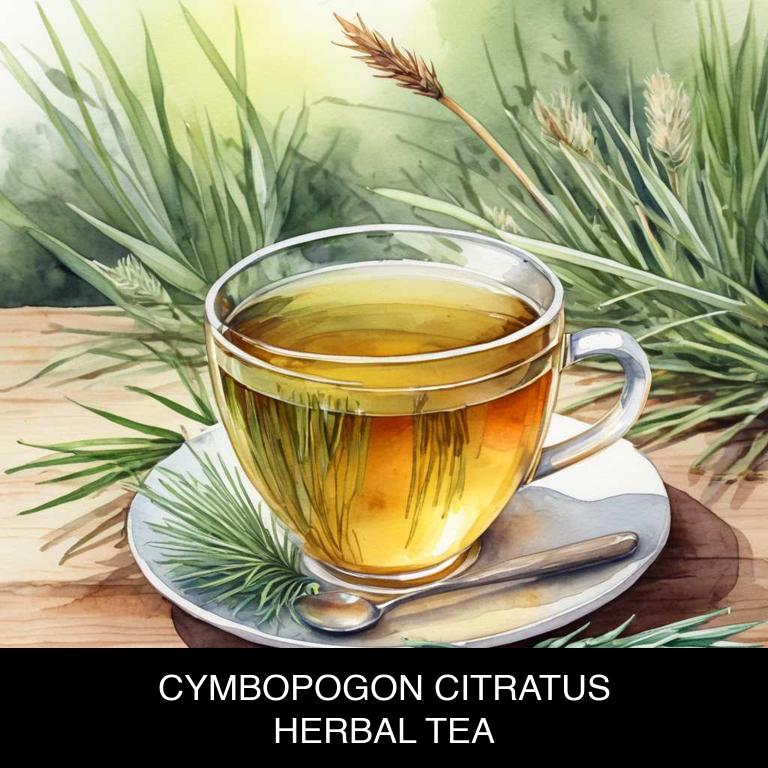
Medicinal Constituents
The list below shows the primary medicinal constituents in Cymbopogon citratus teas that help with dandruff.
- Citral: Helps with dandruff by exhibiting antifungal properties, which can inhibit the growth of Malassezia, a fungus that contributes to scalp conditions.
- Geraniol: Contributes to dandruff relief by displaying anti-inflammatory properties, which can help reduce redness, itching, and flaking associated with scalp irritation.
- Limonene: Assists in dandruff management by exhibiting antifungal and antimicrobial properties, which can help control the growth of Malassezia and prevent the spread of infection.
Parts Used
The list below shows the primary parts of lemongrass used to make teas for dandruff.
- Leaves: They are rich in essential oils, particularly citronella and geraniol, which have antifungal and antibacterial properties that help combat dandruff-causing fungal and bacterial infections.
- Rhyzomes: The rhizomes of Cymbopogon citratus contain compounds like geraniol and citronellal, which have anti-inflammatory and antimicrobial properties that help soothe and calm the scalp, reducing dandruff symptoms.
- Stems: Although less commonly used, the stems of Cymbopogon citratus may also be used to make teas for dandruff, likely due to their ability to contribute to the overall essential oil content of the tea.
Quick Recipe
The following recipe gives a procedure to make a basic lemongrass for dandruff.
- Harvest 1/4 cup of fresh cymbopogon citratus leaves from your garden or a nearby field with permission.
- Rinse the harvested leaves thoroughly under running water for 30 seconds to remove impurities.
- Steep 1 teaspoon of the fresh leaves in 1 cup of boiling water for 5-7 minutes to release flavors.
- Strain the tea mixture through a fine-mesh sieve into a teacup to remove loose leaves.
- Serve the herbal tea immediately and enjoy its refreshing citrus aroma and flavor properties.
7. Echinacea angustifolia
Echinacea angustifolia, also known as Kansas coneflower, teas helps with dandruff because of its potent anti-inflammatory and antifungal properties.
The tea's active compounds, such as alkylamides and caffeic acid, work together to soothe and calm the scalp, reducing inflammation and preventing the growth of fungi that can cause dandruff. Additionally, Echinacea angustifolia's antimicrobial properties help to balance the scalp's natural pH, creating an environment that is less conducive to dandruff-causing microorganisms.
Regular consumption can lead to a reduction in flaking and itchiness.
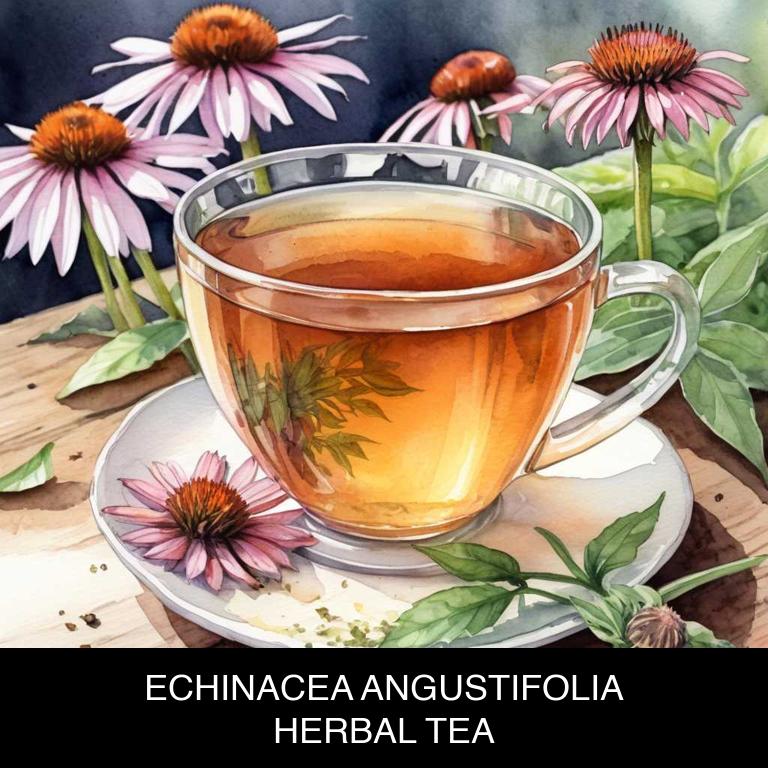
Medicinal Constituents
The list below shows the primary medicinal constituents in Echinacea angustifolia teas that help with dandruff.
- Iridoid glycosides: These compounds have anti-inflammatory properties, which can help reduce redness and inflammation associated with dandruff.
- Alkaloids: Ichoridin and echinacoside, two alkaloids found in Echinacea angustifolia, have been shown to possess antifungal properties, which can help control the growth of malassezia, a fungus that contributes to dandruff.
- Triterpenoid saponins: These compounds have been found to possess anti-inflammatory and antimicrobial properties, which can help soothe the scalp, reduce dandruff flaking, and prevent fungal overgrowth.
Parts Used
The list below shows the primary parts of kansas coneflower used to make teas for dandruff.
- Roots: The roots are commonly used due to their high concentration of compounds like alkylamides and phenylpropanoids that have anti-inflammatory and antifungal properties.
- Leaves: The leaves are often used because they contain flavonoids and phenolic acids that help soothe the scalp and reduce inflammation associated with dandruff.
- Barks: The barks are sometimes used as they contain glycosides and phenolic compounds that exhibit antimicrobial and anti-inflammatory effects, which can aid in treating dandruff.
Quick Recipe
The following recipe gives a procedure to make a basic kansas coneflower for dandruff.
- Gather 1 ounce dried roots of echinacea angustifolia, and store them in an airtight container.
- Steep 1 teaspoon of dried roots in 8 ounces of boiling water for 5 to 10 minutes.
- Strain the liquid using a fine-mesh sieve into a large cup, discard the solids immediately.
- Add honey or sugar to taste, if desired, to sweeten the tea and enhance flavor.
- Drink the tea immediately, or store it in the refrigerator for up to 3 days and reheat.
8. Euphrasia officinalis
Euphrasia officinalis, also known as eyebright, teas helps with dandruff because of its anti-inflammatory and antifungal properties.
The tea's active compounds, such as flavonoids and phenolic acids, help to soothe and calm the scalp, reducing irritation and flaking associated with dandruff. Additionally, eyebright tea's astringent properties help to balance the scalp's natural pH, creating an environment that is less conducive to fungal growth, which can exacerbate dandruff symptoms.
This results in a healthier, flake-free scalp.
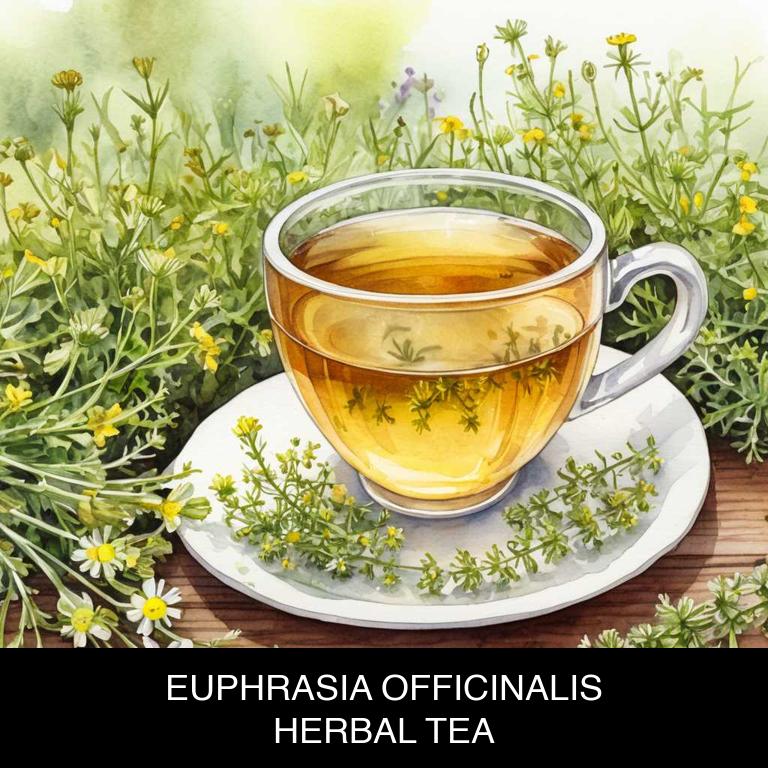
Medicinal Constituents
The list below shows the primary medicinal constituents in Euphrasia officinalis teas that help with dandruff.
- Iridoid glycosides: These compounds exhibit anti-inflammatory and antifungal properties, which help reduce dandruff by soothing and calming the scalp, thereby reducing irritation and infection.
- Flavonoids: Flavonoids, particularly quercetin, possess antioxidant and anti-inflammatory properties, which help protect the scalp from oxidative stress and inflammation, thereby reducing dandruff symptoms.
- Terpenes: Ursolic acid, a terpene present in Euphrasia officinalis, has anti-inflammatory and antimicrobial properties, which help reduce dandruff by inhibiting the growth of fungal pathogens and reducing inflammation in the scalp.
Parts Used
The list below shows the primary parts of eyebright used to make teas for dandruff.
- Leaves: They are used for their antifungal and antibacterial properties, which can help soothe and treat dandruff.
- Flowers: They are used due to their anti-inflammatory properties, which can help reduce redness and irritation associated with dandruff.
- Stems: They are used for their antifungal properties, which can help combat fungal infections that contribute to dandruff.
Quick Recipe
The following recipe gives a procedure to make a basic eyebright for dandruff.
- Harvest 10 grams of euphrasia officinalis leaves and flowers when they are in full bloom and dry them in shade.
- Grind the dried euphrasia officinalis into fine powder using a coffee grinder or mortar and pestle for 5 minutes.
- Combine 1 teaspoon of the powder with 250 milliliters of boiling water in a heat-resistant cup for 5 minutes.
- Steep the mixture for 10 to 15 minutes to allow the flavors and medicinal properties to infuse fully.
- Strain the liquid using a cheesecloth or fine-mesh sieve and discard the solids before serving the tea.
9. Glycyrrhiza glabra
Glycyrrhiza glabra, also known as licorice, teas helps with dandruff because of its anti-inflammatory and antifungal properties.
The licorice root contains compounds like glycyrrhizin and flavonoids that soothe and calm the scalp, reducing irritation and inflammation. Additionally, the antimicrobial properties of licorice root help control the growth of fungal and bacterial organisms that can contribute to dandruff.
As a result, drinking licorice tea or using it as a scalp treatment may help alleviate dandruff symptoms, promoting a healthier and flake-free scalp.

Medicinal Constituents
The list below shows the primary medicinal constituents in Glycyrrhiza glabra teas that help with dandruff.
- Licorice saponins: These saponins help reduce inflammation and soothe the scalp, alleviating itchiness and flakiness associated with dandruff.
- Glucocorticoid-like compounds: The licorice root contains compounds similar to cortisol, which can help reduce inflammation and prevent the over-production of skin cells that contribute to dandruff.
- Phenolic acids: Phenolic acids in Glycyrrhiza glabra teas have antioxidant and anti-inflammatory properties, which can help reduce the severity of dandruff by protecting the scalp from oxidative stress and inflammation.
Parts Used
The list below shows the primary parts of licorice used to make teas for dandruff.
- Roots: The roots are the most commonly used part for teas to treat dandruff due to their high glycyrrhizin content, which has anti-inflammatory properties.
- Leaves: The leaves are used for teas as they contain glycosides that help soothe and calm the scalp, reducing dandruff symptoms.
- Barks: The barks are used for teas as they contain tannins and flavonoids that help to reduce inflammation and itching associated with dandruff.
Quick Recipe
The following recipe gives a procedure to make a basic licorice for dandruff.
- Harvest 2-3 roots of glycyrrhiza glabra, wash them gently with cold water to remove any dirt or debris.
- Chop the roots into small pieces, 2-3 teaspoons for each cup of tea, to increase surface area.
- Steep the chopped roots in 1 cup of boiling water for 5-7 minutes to extract the active compounds.
- Strain the liquid through a fine-mesh sieve or cheesecloth to remove the root particles and sediment.
- Store the herbal tea in the refrigerator for up to 24 hours, ready to drink chilled or hot.
10. Hypericum perforatum
Hypericum perforatum, also known as St John's Wort, teas helps with dandruff because of its antifungal and anti-inflammatory properties.
The tea's active compounds, such as hyperforin and hypericin, work to combat fungal infections that can cause scalp irritation and flaking. By soothing and calming the scalp, Hypericum perforatum tea can help to reduce dandruff symptoms, promoting a healthy and balanced scalp environment.
Regular consumption may lead to improved scalp health and reduced dandruff occurrences.
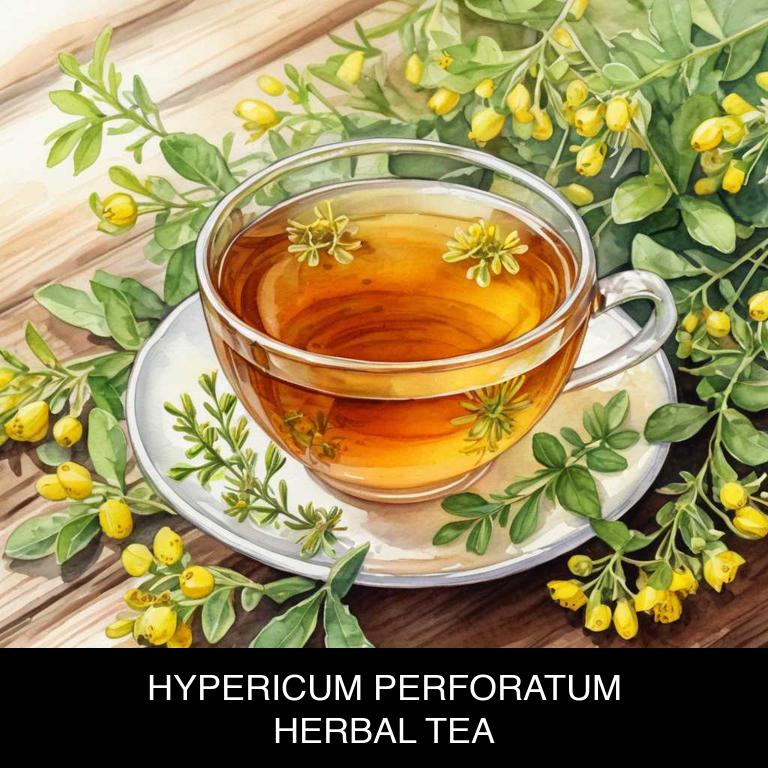
Medicinal Constituents
The list below shows the primary medicinal constituents in Hypericum perforatum teas that help with dandruff.
- Hyperforin: Helps with dandruff by inhibiting the growth of Malassezia yeast, a common fungus linked to scalp irritation and flaking.
- Naphthodianthrones: Contributes to dandruff relief by exhibiting antifungal and antibacterial properties, reducing scalp infections and inflammation.
- Flavonoids: May aid in dandruff management by reducing inflammation and oxidative stress in the scalp, promoting a healthy environment for skin and hair.
Parts Used
The list below shows the primary parts of st john's wort used to make teas for dandruff.
- Leaves: Used due to their antifungal and anti-inflammatory properties, which help soothe and calm the scalp.
- Flowers: Utilized for their antiseptic and antifungal properties, which help combat fungal infections that cause dandruff.
- Stems: Employed for their ability to reduce inflammation and promote healthy scalp conditions.
Quick Recipe
The following recipe gives a procedure to make a basic st john's wort for dandruff.
- Harvest 1-2 cups of fresh flowering tops of hypericum perforatum in late morning when dew is still present.
- Dry the harvested flowers in a single layer at room temperature for 1-2 weeks or use a dehydrator.
- Store the dried flowers in airtight containers to preserve their medicinal properties and flavor.
- Combine 1 teaspoon of dried flowers with 1 cup of boiling water in a heat-resistant cup or teapot.
- Steep the mixture for 5-10 minutes and strain before serving as a calming and relaxing herbal tea.
What is the best combination of herbal teas to use for dandruff?
The best combination of herbal teas that help with dandruff is a blend of peppermint, neem, and rosemary.
Peppermint tea soothes the scalp and reduces inflammation, while neem tea's antifungal properties combat scalp infections that cause dandruff. Rosemary tea's antiseptic properties promote healthy scalp growth and reduce flaking. Drinking a combination of these teas regularly can help alleviate dandruff symptoms and promote a healthy scalp.
They can be consumed individually or in a blend to achieve optimal results.
What ailments similar to dandruff are treated with herbal teas?
Ailments similar to dandruff/teas.html">dandruff/teas.html">dandruff that are treated with herbal teas are eczema, psoriasis, and acne.
Herbal teas like peppermint, chamomile, and calendula have anti-inflammatory properties that soothe itchy skin and reduce inflammation. Rooibos tea is rich in antioxidants that help to calm redness and irritation caused by these conditions.
Drinking these teas may also promote relaxation and reduce stress, which can exacerbate skin issues.